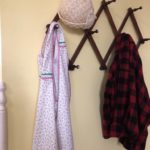
By Robin Mayes, Gallant Farm educator
My husband’s grandmother, Grace Christy Hall, was born in 1895. She was of an older generation than my grandparents and lived her entire life in a rural area. Mine were both born in the early part of the twentieth century and embraced everything modern. My paternal grandma zipped around in a 1965 Chevy Impala with music playing from her state-of-the-art 8-track tape player. My maternal grandmother was an accountant in a small jewelry store and wore heels to work.
Grandma Grace was more like my great-aunts I remembered from when I was little. She was like someone from another time. Although she was only a dozen years older than my grandmothers, she gave me a better glimpse into a little more distant past. She wore her gray hair in a bun on her head and donned an apron every morning. She kept an apron on a peg by the back door and pulled it down and tied it around her waist whenever she returned home from “town.”
When Grandma Grace died, each of the grandchildren listed something of hers that they would like to have. My husband and I discussed it with our kids and it was unanimous – one of her aprons was the thing we wanted to have to remember her by.
Aprons have played an important part in the daily lives of working people throughout history. They were worn to protect the garments worn underneath. In some cases, as in tradesmen like farriers, the thick leather apron was also to protect the person. The style or color of some aprons indicated the trade of the wearer. For instance, stone masons wore white aprons while cobblers chose black. The color or cut of an apron could also indicate status like an English butler’s green apron. Most aprons also serve a utilitarian purpose, such as a carpenter’s apron. With special pockets for nails and a pencil along with a loop to hold the hammer, these canvas aprons are truly handy!

During the last few centuries, aprons were thought to be an essential part of any capable woman’s wardrobe. Housewives were hardly ever caught at home without an apron. In fact, it was customary in some areas to wear a freshly-laundered apron underneath a soiled one so that if company should drop in, the dirty apron could quickly be removed to reveal the more presentable, clean one.
Even little girls of the past wore something to protect their dresses. Often it was a jumper-type apron like a sleeveless dress called a pinafore. Raggedy Ann always wears a pinafore and illustrations of Alice show her in one, as well, as she wanders through Wonderland.
The main purpose of the aprons worn by American housewives was to protect the clothing underneath. Aprons were made of inexpensive fabrics, sometimes from muslin that had begun life as a feed sack. They were much easier to clean than an expensive dress that may contain many yards of material. Simple aprons were often one of the first sewing projects a young girl would tackle.
Not only did aprons save wear and tear on dresses, they were also quite handy in other ways. By holding the two bottom corners, vegetables could be carried from the garden or eggs from the coop. The corner could be an impromptu potholder for opening the oven door. The apron pocket always held a hankie for runny noses and any stray buttons that might be found lying around.
Aprons at the turn of the last century were often white, trimmed with lace. By the 1930s, housewives were dressing them up with rickrack and cute pockets. Embroidered “tea” aprons gave young girls the opportunity to show off their needle skills. By the ‘40s and 50s aprons had become the iconic symbol of domesticity, the uniform of the American housewife. They were decorated with pictures of pots, pans and toasters. June Cleaver wore one for goodness sake! By the late 1960s, however, housework was no longer revered, and aprons became viewed as old-fashioned and a symbol of household drudgery as women began to work more outside of the home. Aprons became relegated to the frilly, stiff affairs reserved for servers at wedding receptions.
Here at Gallant Farm, where we strive to invoke the feel of the Depression era, aprons are an important part of my costume. When I tie one on, I am referring to an apron and it usually means I am ready to greet second-graders! My apron is probably the part of my dress that catches the attention of the kids.
And it is the thing that evokes memories of Grandma in our other visitors.
We have a nice collection of aprons at the farm. Many vintage ones have been donated. A couple of them still retain the price tag from the dime store in which they were purchased so many years ago. Many are handmade. Some are embellished with fancy trim and others are simple.
Today, with the renewed interest in cooking at home coupled with an interest in sewing and crafts, aprons are enjoying a resurgence in popularity. Young people are embracing them once again – whether they are plain and practical or fun and kitschy. They might even be considered (dare I say it?) …retro-chic!
One a side note: some aprons were made of patches of calico, in patchwork patterns that we usually associate with quilts. We’ll have a quilt display at Gallant Farm, Feb. 2-24 with more information on patchwork and how it was used. Come see us!






